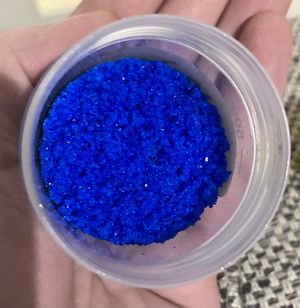Copper(II) nitrate
 Surreal blue copper nitrate hydrate crystals
| |
| Names | |
|---|---|
| IUPAC name
Copper(II) nitrate
| |
| Other names
Copper dinitrate
Cupric nitrate | |
| Properties | |
| Cu(NO3)2 | |
| Molar mass | 187.5558 g/mol (anhydrous) 241.60 g/mol (trihydrate) 232.591 g/mol (hemipentahydrate) |
| Appearance | Blue solid |
| Odor | Odorless |
| Density | 3.05 g/cm3 (anhydrous) 2.32 g/cm3 (trihydrate) 2.07 g/cm3 (hexahydrate) |
| Melting point | 256 °C (493 °F; 529 K) (anhydrous, decomposes) 114.5 °C (trihydrate) 26.4 °C (hexahydrate, decomposes) |
| Boiling point | Decomposes |
| trihydrate 381 g/100 mL (40 °C) 666 g/100 mL (80 °C) hexahydrate 243.7 g/100 mL (80 °C) | |
| Solubility | Hydrates very soluble in ethanol, ammonia, water; insoluble in ethyl acetate, halocarbons |
| Hazards | |
| Safety data sheet | Sigma-Aldrich |
| Flash point | Non-flammable |
| Lethal dose or concentration (LD, LC): | |
| LD50 (Median dose)
|
940 mg/kg (rat, oral) |
| Related compounds | |
| Related compounds
|
Zinc nitrate |
| Except where otherwise noted, data are given for materials in their standard state (at 25 °C [77 °F], 100 kPa). | |
| Infobox references | |
Copper(II) nitrate is a blue salt of copper with the chemical formula Cu(NO3)2. It is commonly encountered as hydrated form.
Contents
[hide]Properties
Chemical
Decomposition of copper nitrate yields nitrogen dioxide gas.
- 2 Cu(NO3)2 → 2 CuO + 4 NO2 + O2
This reaction is a cheap source of nitrogen dioxide, which can be bubbled through water to generate nitric acid through the following reaction:
- 3 NO2 + H2O → 2 HNO3 + NO
Bubbling it through hydrogen peroxide is much more efficient.
- 2 NO2 + H2O2 → 2 HNO3
In combination with acetic anhydride, it is an effective reagent for nitration of aromatic compounds.
As with many other copper(II) salts, copper(II) nitrate yields a blue to green coloration in flame tests. Unlike other copper compounds, though, the nitrate is also an oxidizer, making it useful for producing brilliantly colored flames in pyrotechnics without slowing down the reactions too much. The resulting mixture can not be stored however, due to the strong hygroscopicity of copper(II) nitrate.
Physical
Anhydrous copper nitrate is deep-blue-green. It is highly hygroscopic and will turn into at least 5 hydrates, as it absorbs more and more water. The hydrates are blue and hygroscopic. The hydrates cannot be dried by heating, as this will decompose the salt, leaving black copper(II) oxide and will give off nitrogen dioxide and nitric acid fumes.
Copper nitrate solutions can occasionally change their color from blue-green to green.
Availability
Copper nitrate is available as both anhydrous and hydrate at many chemical suppliers as well as on Ebay.
Preparation
Copper nitrate hydrated can be prepared by reacting copper with nitric acid.
- Cu + 4 HNO3 → Cu(NO3)2 + 2 H2O + 2 NO2
It can also be prepared by mixing two concentrated solutions of calcium nitrate and copper(II) sulfate. Calcium sulfate will precipitate, while the much more soluble copper nitrate will remain in solution. Filter the solution (it's recommended you use vacuum filtration as gypsum tends to hold water). The resulting solution is dried in a desiccator at room temperature, or just a bit higher, to avoid decomposing the fragile salt. When it's dried, the resulting blue-green crystals have a fluffy aspect. They should be stored in sealed dry bottles, as they're hygroscopic.
Anhydrous copper nitrate synthesis eluded chemists for a long time, but in 1969 a method was discovered. By adding dinitrogen tetroxide to copper metal in anhydrous conditions, and then gently heating the resulting product to 80 °C to get rid of the nitrogen oxides, pure anhydrous copper nitrate is produced.
- Cu + 2 N2O4 → Cu(NO3)2 + 2 NO[1]
Projects
- Nitric acid synthesis
- Nitrating aromatic compounds
- Blue-green flames in pyrotechnics
Handling
Safety
Being a water-soluble copper salt, copper(II) nitrate is of moderate toxicity. Contact between copper(II) nitrate with mineral acids or strongly heating it should be avoided, as it will give off nitrogen dioxide fumes that are very toxic and corrosive. When attempting to crystallize the solution, even gentle heating is not a good option, as it will slowly decompose and turn into a green slush, which is impossible to dry and useless. Drying it with a desiccator is a slow but good way. Copper nitrate will slowly hydrolyze in an aqueous solution, to yield nitric acid.
Storage
Both the anhydrous and hydrated form should be stored in hermetic sealed containers, as they're very hygroscopic.
Disposal
Copper nitrate can be reduced with iron or zinc to elemental copper, which is less harmful. Solutions should never be poured down the drain.
Heating copper nitrate will result in nitrogen oxide fumes and copper oxide, that too requires disposal.
References
- Jump up ↑ H.Wayne Richardson "Copper Compounds" Ullmann's Encyclopedia of Industrial Chemistry 2005, Wiley-VCH, Weinheim